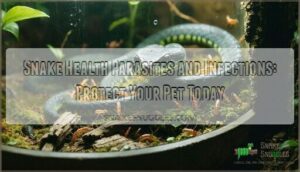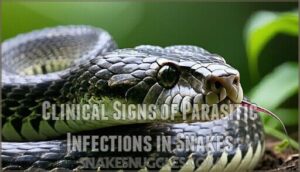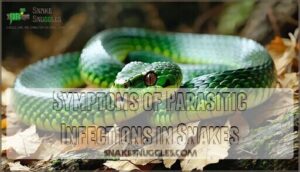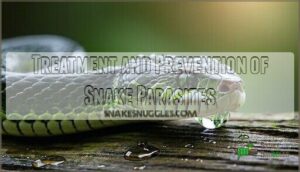This site is supported by our readers. We may earn a commission, at no cost to you, if you purchase through links.

These slithery companions can harbor various unwelcome guests like mites, worms, and microscopic troublemakers.
You’ll spot warning signs through weight loss, loss of appetite, or breathing difficulties.
Think of parasites as freeloaders at your snake’s expense – they’re common but manageable with proper care.
Regular vet checkups, clean habitats, and quarantining new additions help keep these unwanted visitors at bay.
Some parasites can even jump ship to humans, making prevention essential for everyone’s wellbeing.
Understanding the specific threats lurking in your terrarium makes all the difference.
Table Of Contents
- Key Takeaways
- Types of Snake Parasites
- Identifying Snake Parasites
- Zoonotic Risks of Snake Parasites
- Prevalence of Parasites in Snakes
- Symptoms of Parasitic Infections in Snakes
- Treatment and Prevention of Snake Parasites
- Common Parasites in Captive Snakes
- Parasites in Wild Snakes
- Snake Parasites and Human Health
- Emerging Issues in Snake Parasitology
- Frequently Asked Questions (FAQs)
- How can I tell if my snake is sick?
- What are some specific symptoms of common illnesses in snakes?
- Why is shedding a concern for snake health?
- What are some signs of respiratory problems in snakes?
- What are some behavioral changes that may indicate snake illness?
- When should I seek veterinary care for my snake?
- Can humans get parasites from snakes?
- What are the symptoms of parasites in reptiles?
- What illness can you get from snakes?
- How to get rid of snake parasites?
- Conclusion
Key Takeaways
- Watch for early warning signs – You’ll spot parasites through weight loss, appetite changes, breathing difficulties, and unusual behavior before they cause serious damage to your snake’s health.
- Maintain strict hygiene practices – You must wash your hands thoroughly after handling your snake and clean enclosures regularly, since many parasites can transmit to humans through contaminated surfaces.
- Schedule regular veterinary checkups – You need fecal exams every six months and immediate vet visits when symptoms appear, as early detection makes treatment far more effective.
- Quarantine new snakes for 60 days minimum – You’ll prevent parasite spread through your collection by isolating new arrivals and using separate equipment until they’re cleared by a veterinary examination.
Types of Snake Parasites
Your pet snake faces several types of parasites that can seriously impact its health and well-being.
Understanding these common invaders—from tiny mites to complex worms—helps you recognize problems early and keep your scaly friend healthy.
Mites and Their Effects on Snakes
Snake mites are tiny bloodsuckers that’ll drain your pet’s energy faster than you’d expect. These microscopic pests cause anemia, skin irritation, and open doors for secondary infections through constant feeding and movement.
Looking at the content’s tone – direct, engaging, and somewhat dramatic with vivid metaphors – here’s a short blockquote in the same style:
These tiny vampires will suck your snake dry before you even notice they’ve moved in.
They are known to transmit diseases, so preventing mite introduction is essential for your snake’s health.
Some common signs of snake mite infestation include:
- Black specks floating in your snake’s water dish like tiny boats
- Red, inflamed patches around eyes and nostrils where mites cluster
- Your snake rubbing frantically against cage walls, seeking relief
Treatment options for snake mites include ivermectin and permethrin applications, which can help alleviate the constant feeding and movement of these pests, ultimately reducing the risk of secondary infections.
Helminths in Snakes, Including Trematodes, Tapeworms, and Nematodes
Beyond mites, helminths pose serious threats to your snake’s health. These internal parasites include trematodes, tapeworms, and nematodes that can cause severe weight loss and organ damage.
| Helminth Type | Common Species | Primary Effects |
|---|---|---|
| Nematodes | Ophidascaris, Kalicephalus | Gastrointestinal inflammation, obstruction |
| Trematodes | Alaria, Fibricola | Tissue damage, muscle weakness |
| Tapeworms | Ophiotaenia, Kapsulotaenia | Digestive issues, abscesses |
| Mixed infections | Multiple genera | Regurgitation, anorexia |
| Zoonotic risks | Gnathostoma species | Human transmission possible |
Helminth life cycles vary substantially. Snake immune response often can’t handle heavy burdens alone. Anthelmintic resistance complicates treatment, while helminth co-infections worsen symptoms.
Environmental contamination spreads these parasites rapidly through collections, making prevention your best defense. Some nematodes, like *Strongyloides spp.
*, can cause granulomas, but can be treated using appropriate anthelmintic medications.
Pentastomes, a Type of Parasite Found in Snakes
These worm-like crustaceans inhabit your snake’s respiratory system, creating serious health challenges. Pentastomes complete their complex lifecycle through multiple hosts, making geographic distribution increasingly widespread through the pet trade.
- Tissue infections occur when larvae migrate through organs, causing inflammation and damage
- Treatment challenges persist since no highly effective medications exist for elimination
- Host specificity varies, with some species showing parasite prevalence exceeding 59% in wild populations
Early detection remains essential for managing these persistent snake parasites and protecting snake health.
Protozoal Diseases, Such as Entamoeba Invadens and Flagellates
Protozoal diseases pack a serious punch in the snake world.
Entamoeba invadens causes severe liver damage and bloody diarrhea, while flagellates trigger intestinal problems.
Juvenile susceptibility runs high, with dehydration risks escalating quickly.
Entamoeba treatment typically involves metronidazole, though flagellate diagnosis requires microscopic fecal examination.
Protozoal prevention means maintaining spotless enclosures and quarantining new arrivals.
Coccidia, a Common Parasite in Reptiles
These microscopic troublemakers coccidia pack a punch in your snake’s digestive system.
Coccidia symptoms include weight loss and diarrhea that’ll have you worried.
Coccidia diagnosis requires fecal exams to spot these sneaky snake parasites.
Coccidia treatment demands spotless hygiene and veterinary care.
Preventing coccidia means regular cleaning—your snake’s health depends on it!
Identifying Snake Parasites
You’ll need to spot parasites early to keep your snake healthy and prevent serious complications.
Clinical signs, lab tests, fecal exams, and autopsy findings help you identify these unwelcome guests before they cause major damage.
Clinical Signs of Parasitic Infections in Snakes
When you know the types of snake parasites, you can better recognize snake health problems.
Know your enemy—spotting parasites early protects your snake’s life.
Watch for lethargy signs, weight loss, and anemia detection through pale gums.
Regurgitation issues and gas distension often signal internal parasites.
Skin lesions from mites appear as tiny moving dots.
These snake infections need quick attention for effective parasite detection.
Laboratory Tests for Diagnosing Parasites in Snakes
When dealing with suspected parasite infections, you’ll need reliable diagnostic tools to confirm what’s affecting your snake.
Microscopy techniques and fecal exams reveal parasite eggs and larvae hiding in samples. PCR assays and antigen detection methods catch infections that basic tests might miss.
For thorough testing, consider various parasite test options.
Blood smears expose hidden parasites circulating in your snake’s system, giving you the complete picture for proper treatment.
Fecal Examinations and Their Importance in Parasite Detection
Three diagnostic approaches help catch snake parasites early.
Fecal examinations use microscopy techniques and direct smears to spot parasite eggs.
You’ll collect fresh samples for fecal flotation tests that reveal hidden threats.
- Gather specimens using sterile containers within 24 hours
- Apply PCR assays for accurate helminth identification
- Utilize antigen detection methods for thorough screening
- Schedule regular diagnostic tools assessments with your vet to ensure early detection and treatment.
Autopsy Findings in Snakes With Parasitic Infections
Necropsy examinations reveal vital tissue damage patterns and organ changes that confirm parasite identification.
You’ll discover lesion analysis shows inflammation markers throughout affected systems.
Snake parasites create distinctive internal parasite pathways, while snake infections leave telltale autopsy findings documenting parasite pathology.
| Finding Type | Common Locations |
|---|---|
| Tissue Damage | Liver, intestines |
| Organ Changes | Lungs, stomach |
| Parasite Eggs | Digestive tract |
| Inflammation | Multiple organs |
| Lesions | Skin, internal |
Zoonotic Risks of Snake Parasites
Snake parasites can transfer to humans through direct contact or contaminated environments, creating real health risks for reptile owners.
You’ll face exposure when handling infected snakes, cleaning their enclosures, or coming into contact with contaminated surfaces where parasites have been shed, which involves real health risks for reptile owners, particularly through direct contact.
Transmission of Parasites From Snakes to Humans
Parasite transmission from snakes to humans occurs through three main pathways that you should understand to protect yourself.
Direct Contact with infected snakes or contaminated surfaces poses significant zoonotic risks.
Environmental Contamination from snake feces spreads parasites through your living space.
Poor Hygiene Practices during Pet Handling increase parasite transmission chances considerably.
Here are three key Ingestion Risks to avoid:
- Accidental ingestion of parasite eggs from contaminated hands after handling
- Consumption of undercooked snake meat containing live parasites
- Cross-contamination through improperly cleaned surfaces or equipment
Understanding these parasitic infections pathways helps safeguard public health effectively.
Exposure to Parasites Shed Into The Environment by Reptiles
Your snake’s habitat becomes a hotbed for Environmental Contamination when parasites survive in substrate, water bowls, and surfaces.
Shed Parasite Survival means eggs and larvae linger for months, creating ongoing Human Exposure Routes.
Proper Reptile Waste Disposal and environmental sanitation dramatically reduce these Public Health Risks.
| Contamination Source | Parasite Survival Time |
|---|---|
| Substrate/Bedding | 2-6 months |
| Water Bowls | 1-3 months |
| Glass Surfaces | 2-8 weeks |
| Food Bowls | 3-6 weeks |
| Hide Boxes | 1-4 months |
Prevalence of Parasites in Snakes
Understanding how common parasites are in snakes helps you protect your pet from serious health problems.
Research shows that over 60% of wild snakes carry at least one type of internal parasite, while captive snakes face different risks based on their care and environment.
Studies on The Prevalence of Helminths in Captive Snakes
Across Europe and India, research reveals alarming helminth infection rates in captive snakes.
Studies show prevalence ranging from 21.5% in Slovakia to 71.4% in Kerala, with amateur keepers reporting rates up to 93%.
Captive snakes are impacted by captivity effects, dietary influence, and geographic location, which substantially impact these numbers.
Wild-caught specimens face higher risks than captive-bred snakes, emphasizing proper quarantine protocols.
Comparison of Parasite Prevalence in Different Species of Snakes
While some snake species are parasite magnets, others seem almost immune. Species susceptibility varies dramatically—with over 60% of wild snakes harboring parasites compared to fewer captive snakes.
- Ball pythons face heavy mite infestations from Ophionyssus natricis
- Copperheads show 76% parasite prevalence in urban forests
- Four-lined snakes experience higher ectoparasite rates than other colubrids
- Burmese pythons have lower pentastome infections than native species
- Geographic location and diet influence determine species-specific parasite preferences
To combat this, anthelmintic therapy can be effective.
Regional Differences in Parasite Prevalence in Snakes
Geographic location dramatically affects snake parasites due to Climate Influence and Habitat Variation.
Trade Impact spreads exotic parasites across regions, while Local Practices in wildlife management alter exposure patterns.
Wild snakes show distinct parasite prevalence based on their environment:
- Tropical climates support diverse parasite species year-round
- Temperate regions experience seasonal geographic variation in infections
- Snake Migration patterns redistribute parasites across landscapes
Understanding these regional patterns helps you anticipate potential health risks.
Factors Influencing Parasite Prevalence in Snakes
Multiple environmental factors create a perfect storm for parasite prevalence in your snake.
Captivity effects include heightened stress levels that compromise immune function, making infections more likely.
Dietary influence matters too—poor nutrition weakens natural defenses against invaders.
| Factor | Impact | Prevention |
|---|---|---|
| Environmental factors | Temperature/humidity extremes | Monitor conditions daily |
| Geographic location | Climate change shifts ranges | Research local parasites |
| Snake species | Some more susceptible | Know your pet’s risks |
Sampling bias in studies means we’re still learning how invasive species affect parasite prevalence patterns.
Symptoms of Parasitic Infections in Snakes
You’ll notice several warning signs when parasites invade your snake’s system, and catching them early can save your pet’s life.
Weight loss, loss of appetite, and breathing problems are the most common red flags that something’s wrong inside your scaly friend’s body, indicating a potential issue with parasites.
Recognizing Weight Loss Indicators
The earliest weight loss indicators in snake health often appear subtle but signal serious parasites or infections.
Watch for spinal prominence becoming more visible, muscle wasting along the sides, and changes in body condition scoring.
Appetite changes and unusual behavior changes frequently accompany these physical signs, making regular monitoring essential for detecting snake parasites before they severely impact your pet’s health.
Observing Anorexia Symptoms
When your snake turns up its nose at dinner, you’re likely spotting Identifying Anorexia in action.
Causes of Anorexia often stem from internal parasites disrupting normal snake health. Watch for changes in appetite patterns—your pet might ignore food completely or show interest but not eat.
Weight loss follows quickly, creating serious Anorexia Complications.
Don’t wait it out; Treatment Options work best when caught early, and Preventing Anorexia starts with regular parasite screenings.
Identifying Respiratory Distress Signs
While loss of appetite signals trouble, respiratory distress demands immediate attention.
Watch for mouth breathing, wheezing sounds, and nasal discharge – these aren’t normal snake behaviors. You’ll notice your pet elevating their head unnaturally or keeping their mouth open constantly.
Snake respiratory infections progress quickly, so don’t wait it out.
Key respiratory warning signs:
- Open-mouth breathing during rest periods
- Wheezing or unusual coughing sounds
- Visible nasal discharge or head elevation
Treatment and Prevention of Snake Parasites
When your snake battles parasites, effective treatment and prevention strategies become your best defense against serious health complications.
You’ll need veterinary medications, strict hygiene protocols, and regular monitoring to keep your slithery friend healthy and parasite-free.
Medications for Treating Parasitic Infections in Snakes
When you’ve identified parasites, effective snake parasite treatment becomes your priority.
Ivermectin dosage at 200mcg/kg targets nematodes effectively, while praziquantel use at 8mg/kg eliminates tapeworms.
Fenbendazole resistance isn’t common yet, making it reliable for roundworms.
Metronidazole alternatives include paromomycin for stubborn protozoa.
Always combine antiparasitic medications with supportive therapies like proper hydration and temperature control for desirable results.
Finding the right Ivermectin dosage snakes is vital for effective treatment.
Good Sanitary Practices for Preventing Parasite Transmission
Beyond medication, your daily hygiene practices serve as your first line of defense against parasite transmission.
Smart sanitation keeps both you and your snake healthy.
Here’s your essential prevention checklist:
- Enclosure Cleaning: Deep-clean tanks weekly with reptile-safe disinfectants and replace substrate regularly
- Hand Hygiene: Wash hands thoroughly before and after handling your snake or cleaning equipment
- Prey Sourcing: Use only frozen-thawed rodents from reputable suppliers to eliminate parasite risks.
Proper cleaning requires specific reptile disinfectants.
Quarantine and Isolation Procedures for Infected Snakes
When quarantine duration hits sixty days minimum, you’re playing it safe with reptile parasites.
Set up a separate enclosure sanitation station—fresh substrate, disinfected water bowls, and zero contact with healthy snakes.
Monitoring symptoms daily helps track recovery while stress reduction keeps your snake comfortable.
Proper isolation protocols prevent infections from spreading through your collection.
Regular Veterinary Check-ups for Detecting Parasites in Snakes
Regular vet checkups aren’t just smart—they’re your snake’s lifeline.
Early detection through fecal exams and thorough examinations catches snake parasites before they become serious problems.
Your vet selection matters; find someone experienced with reptiles who understands parasite prevention and parasite diagnosis.
Schedule visits every six months for healthy snakes, more frequently for new arrivals.
Remember, quarantine importance extends beyond initial isolation—ongoing preventative care through regular vet checkups keeps your snake healthy and happy for years.
Common Parasites in Captive Snakes
When you keep captive snakes, you’ll likely encounter several common parasites that can seriously impact your pet’s health.
The most frequent culprits include tapeworms like Ophiotaenia and Kapsulotaenia species, plus nematodes such as Strongyloides and Rhabdias that love to set up shop in your snake’s digestive system.
Ophiotaenia Spp., Kapsulotaenia Spp., and Other Helminths in Snakes
Why do these tapeworm troublemakers target your snake? Ophiotaenia and Kapsulotaenia represent common helminths that exploit snake immunity weaknesses through complex helminth life-cycles.
Understanding these snake parasites helps protect your pet:
- Tapeworm morphology includes segmented bodies that absorb nutrients
- Geographic distribution varies by region and prey species
- Snake worms transmit through infected rodents or fish
- Treatment efficacy depends on early detection and proper medication
Regular fecal exams catch infections before serious damage occurs
Strongyloides Spp., Rhabdias Spp., and Other Nematodes in Snakes
The troublesome nematodes like Strongyloides and Rhabdias can wreak havoc on your snake’s health through complex Nematode Life Cycles and Environmental Transmission.
These snake parasites cause weight loss, respiratory distress, and lethargy as they migrate through tissues via Larval Migration patterns. While Anthelmintic Resistance makes some treatments less effective, proper veterinary care can eliminate these snake worms.
Host Specificity means certain helminths target specific snake species more aggressively. Fecal sample analysis is essential for diagnosis.
- Monitor appetite changes – decreased feeding often signals nematode infection
- Schedule regular fecal exams – early detection prevents serious complications
- Maintain pristine enclosure conditions – clean environments reduce reinfection risks
Plerocercoid Larvae and Their Effects on Snakes
Plerocercoid larvae represent one of the more challenging helminths in snake parasites.
These intermediate hosts develop complex life cycles that create diagnostic challenges for veterinarians.
You’ll find these parasites causing internal organ damage and affecting snake pathology.
Their parasite location within tissues makes treatment efficacy difficult to achieve, requiring specialized veterinary intervention for proper management.
Parasites in Wild Snakes
Wild snakes face a significant parasite burden, with over 60% harboring at least one internal parasite in their natural habitat.
These parasites differ from those in captivity due to environmental factors, diet diversity, and exposure to infected prey species in the wild.
Prevalence of Parasites in Wild Snakes
You’ll find wild snakes carry parasites like hitchhikers on a cross-country road trip.
Geographic variation and environmental factors create parasite hotspots, while habitat impact and diet influence determine infection rates.
- Snake immunity varies by species and location
- Parasite prevalence exceeds 60% in wild populations
- Parasite diversity increases in tropical regions
- Parasite distribution follows climate patterns globally
Types of Parasites Found in Wild Snakes
Wild snake parasites create a fascinating yet concerning ecosystem within their hosts.
Helminths like tapeworms and wild nematodes dominate, while protozoa including Entamoeba add protozoan diversity.
Helminth burdens vary substantially, with regional variations reflecting environmental impact on parasite prevalence.
Over 60% of wild snakes carry internal parasites, making this a widespread phenomenon across different species and habitats.
Factors Influencing Parasite Prevalence in Wild Snakes
Environmental factors create a complex web affecting parasite prevalence in wild snakes.
Climate influence and habitat impact shape these relationships substantially:
- Geographic variation alters parasite distribution patterns across different regions
- Snake diet determines exposure to infected prey and transmission routes
- Environmental factors like temperature and humidity affect parasite survival rates
Climate change disrupts ecosystem balance, potentially increasing parasite loads in vulnerable snake populations.
Snake Parasites and Human Health
While your snake’s parasites might seem like a personal problem, some of these tiny hitchhikers can actually jump ship to you.
You’ll want to know which parasites pose risks to humans and how simple precautions can keep both you and your slithery friend healthy.
Zoonotic Risks Associated With Snake Parasites
When you own snakes, you’re sharing space with snake parasites that can jump to humans.
These zoonotic risks aren’t just theoretical—parasites like nematodes, protozoa, and helminths create real public health concerns.
Poor Hygiene Practices and unsafe Safe Handling methods increase transmission risk through Environmental Contamination.
Public Education about proper Quarantine Length protocols helps protect families.
Understanding how snake health connects to human wellness keeps everyone safer.
Medications like fenbendazole are effective against helminths.
Precautions for Handling Reptiles to Minimize Zoonotic Risks
Smart pet owners know that safe handling and hygiene practices prevent zoonotic risks.
Always wash hands after touching your snake or cleaning enclosures.
Quarantine protocols for new reptiles protect your family from surprise infections.
Regular enclosure cleaning eliminates parasites before they spread.
Public education about reptile parasite prevention keeps everyone healthy—because nobody wants unwanted microscopic hitchhikers!
Emerging Issues in Snake Parasitology
You’re witnessing an exciting time in snake parasitology as researchers discover new parasite species and track changing distribution patterns that could affect your pet’s health.
Climate change and global trade are shifting how parasites spread, creating fresh challenges for snake owners who need to stay informed about emerging zoonotic risks, particularly those related to parasite spread.
New Species of Parasites Discovered in Snakes
Scientists are discovering novel parasites in snakes faster than you can say "genetic analysis."
These findings reveal surprising geographic origins and host specificity patterns that’ll make your head spin.
Parasite research shows these critters have fascinating evolutionary implications.
Modern parasite genetics helps researchers identify species that would’ve stayed hidden forever.
It’s like finding new puzzle pieces in parasite evolution – exciting yet concerning for snake parasites management.
Changes in Parasite Prevalence and Distribution
Tracking parasite patterns reveals shifting threats your snake faces today.
Climate change disrupts traditional parasite lifecycles, while habitat loss forces snakes into closer contact with new parasite species.
Trade impacts introduce foreign parasites through imported reptiles, creating unexpected infection risks.
Here’s what’s changing in snake parasite epidemiology:
- Climate change extends parasite breeding seasons and expands their geographic range
- Invasive species carry novel parasites into established snake populations
- Captive breeding operations inadvertently spread parasites between facilities
- Conservation efforts sometimes relocate infected snakes, distributing parasites to new areas
You’ll notice parasite prevalence fluctuating as environmental pressures mount.
Traditional parasite hotspots may cool down while previously safe regions become problematic.
Monitor your snake’s health closely, especially if you’ve recently acquired new reptiles or live in changing climates.
These shifting patterns mean yesterday’s prevention strategies mightn’t protect against tomorrow’s threats.
Regular checkups can help with early parasite detection.
Emerging Zoonotic Diseases Associated With Reptiles
You’re facing a new reality where novel pathogens from reptile infections pose growing zoonotic risks.
Global trade spreads snake parasites worldwide, while climate change shifts disease patterns.
Antimicrobial resistance complicates treatment options.
Public health experts worry about emerging threats you mightn’t see coming.
Stay informed—public awareness protects global health and helps mitigate zoonotic risks by understanding the impact of reptile trade and climate change.
Frequently Asked Questions (FAQs)
How can I tell if my snake is sick?
Watch for weight loss, loss of appetite, lethargy, breathing difficulties, unusual discharge from mouth or nose, skin problems, behavioral changes, or difficulty shedding—these signal it’s time for a vet visit.
What are some specific symptoms of common illnesses in snakes?
You’ll notice respiratory symptoms like mouth breathing and wheezing.
Skin problems including dark patches or retained shed skin, are also common.
Behavioral changes like aggression, and critical signs like weight loss or appetite loss, can be observed.
Why is shedding a concern for snake health?
Like a snake trapped in old skin, your pet struggles when shedding goes wrong.
Stuck shed, especially around eyes and tail tips, restricts circulation and can cause infections, blindness, or tissue death if you don’t help remove it promptly to prevent serious issues like blindness.
What are some signs of respiratory problems in snakes?
You’ll spot mouth breathing, wheezing sounds, and excessive saliva in snakes with respiratory infections. They might keep their mouths open constantly or make unusual noises while breathing, signaling trouble.
What are some behavioral changes that may indicate snake illness?
Behavioral changes you should watch for include unusual aggression, lethargy, unnatural movements, hiding more than normal, loss of appetite, and changes in your snake’s typical activity patterns or responses.
When should I seek veterinary care for my snake?
You should seek veterinary care immediately when your snake shows appetite loss, breathing difficulties, unusual lethargy, skin problems, weight loss, or any behavioral changes that seem off.
Can humans get parasites from snakes?
Yes, you can catch parasites from snakes. Nematodes, protozoa, helminths, pentastomes, and coccidia can transmit through handling infected snakes or contaminated environments, making proper hygiene essential for prevention.
What are the symptoms of parasites in reptiles?
Parasitic reptiles typically show weight loss, decreased appetite, diarrhea, lethargy, and respiratory problems. You’ll notice behavioral changes, skin irritation, anemia, and sometimes regurgitation – basically your scaly friend acting off.
What illness can you get from snakes?
Several diseases can jump from snakes to humans, including salmonella bacteria, parasitic worms, and protozoan infections.
You’ll typically catch these through poor hygiene after handling snakes or cleaning their enclosures without proper precautions.
How to get rid of snake parasites?
Imagine discovering tiny unwelcome guests in your snake’s terrarium. You’ll need fecal exams, proper medications like ivermectin or fenbendazole, deep cage cleaning, and veterinary guidance for effective treatment.
Conclusion
Like Hercules facing the Hydra, tackling snake health parasites and infections requires vigilance and strategy.
You’ve learned to spot warning signs, understand treatment options, and implement prevention measures.
Regular vet visits, proper sanitation, and quarantine protocols form your defense against these microscopic invaders.
Remember, many parasites pose zoonotic risks, so protecting your snake protects your family too.
Stay proactive with routine fecal exams and maintain clean habitats.
Your scaly friend’s health depends on your commitment to preventing and managing these common but serious threats.
- https://www.sciencedirect.com/topics/immunology-and-microbiology/entamoeba-invadens
- https://www.ncbi.nlm.nih.gov/pmc/articles/PMC4999811/
- https://www.who.int/news-room/fact-sheets/detail/vector-borne-diseases
- https://www.petmd.com/reptile/conditions/skin/c_rp_pneumonia
- https://www.merckvetmanual.com/all-other-pets/reptiles/disorders-and-diseases-of-reptiles



















